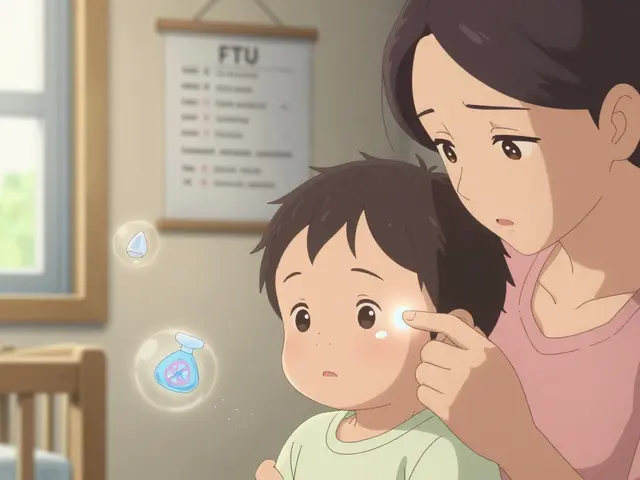Understanding Leukemia and Its Types
Before diving into the connection between leukemia and graft-versus-host disease, it is essential to understand what leukemia is and its different types. Leukemia is a type of cancer that affects the blood and bone marrow, the spongy tissue inside bones where blood cells are made. It occurs when the body produces a high number of abnormal white blood cells, which are unable to fight infections properly and can lead to various health issues.
There are four main types of leukemia: Acute Lymphoblastic Leukemia (ALL), Acute Myeloid Leukemia (AML), Chronic Lymphocytic Leukemia (CLL), and Chronic Myeloid Leukemia (CML). Each type of leukemia has unique characteristics, treatment options, and prognoses, so understanding the specific type is critical for managing the disease effectively.
Graft-Versus-Host Disease: A Common Complication of Stem Cell Transplants
Graft-versus-host disease (GVHD) is a common and potentially severe complication of stem cell transplants, which are often used as a treatment for leukemia. Stem cell transplants involve replacing a patient's diseased bone marrow with healthy bone marrow from a donor. This new bone marrow helps the body produce healthy blood cells and can potentially cure the leukemia.
However, GVHD can occur when the donor's immune cells, which are also present in the donated bone marrow, start attacking the recipient's healthy tissues. This is because the donor's immune cells recognize the recipient's body as foreign and try to eliminate it. GVHD can have various symptoms, ranging from mild to life-threatening, and it is crucial to manage it properly to ensure the success of the stem cell transplant.
How Leukemia and Graft-Versus-Host Disease Are Connected
The connection between leukemia and graft-versus-host disease lies in the treatment of leukemia. As mentioned earlier, stem cell transplants are a common treatment option for leukemia patients, especially for those with high-risk or aggressive forms of the disease. While stem cell transplants can be lifesaving, they come with the risk of developing GVHD.
The incidence of GVHD in leukemia patients who receive stem cell transplants varies depending on factors such as the type of leukemia, the donor's relationship to the recipient, and the specific transplant procedure used. However, it is a well-established fact that leukemia patients undergoing stem cell transplants are at risk of developing GVHD.
Preventing and Managing GVHD in Leukemia Patients
Preventing and managing GVHD in leukemia patients is a critical aspect of ensuring the success of stem cell transplants. One of the primary ways to prevent GVHD is by carefully selecting the donor for the transplant. Ideally, the donor should be a close relative, such as a sibling, as this reduces the risk of GVHD due to a closer genetic match.
In addition to donor selection, doctors may also use various medications to suppress the recipient's immune system, making it less likely for GVHD to occur. These medications, known as immunosuppressive drugs, are usually given to the patient before, during, and after the transplant.
If GVHD does occur, it is essential to manage it promptly and effectively. This may involve using medications to control the symptoms, adjusting the immunosuppressive drugs, or, in severe cases, using additional treatments such as photopheresis or extracorporeal photopheresis (ECP).
The Graft-Versus-Leukemia Effect: A Double-Edged Sword
Interestingly, GVHD is not always entirely harmful to leukemia patients who have undergone stem cell transplants. In some cases, the donor's immune cells that cause GVHD may also attack and kill the patient's leukemia cells, leading to a beneficial phenomenon known as the graft-versus-leukemia (GVL) effect.
The GVL effect can significantly improve the chances of long-term remission and cure in leukemia patients. However, it is a double-edged sword since it is also associated with the development of GVHD, which can be harmful and even life-threatening. Therefore, striking the right balance between the GVL effect and GVHD is crucial for the success of stem cell transplants in leukemia patients.
Future Directions in Leukemia and GVHD Research
Understanding the connection between leukemia and graft-versus-host disease is critical for improving the outcomes of stem cell transplants in leukemia patients. Researchers are constantly working to develop new strategies for preventing and managing GVHD while preserving the beneficial GVL effect.
One promising area of research involves using modified immune cells, known as chimeric antigen receptor (CAR) T-cells, to treat leukemia. These cells can potentially target and kill leukemia cells without causing GVHD, offering a potentially safer and more effective treatment option for patients.
As our understanding of leukemia and GVHD continues to grow, it is hoped that new breakthroughs will lead to better treatment options and improved outcomes for leukemia patients undergoing stem cell transplants.





19 Comments
Penn Shade
April 29, 2023Leukemia isn’t some random glitch; the transplant process is deterministic. The graft‑versus‑host phenomenon is a direct immunological consequence of donor T cells recognizing host antigens. This is why the GVL effect exists – the same cells that cause GVHD also hunt residual leukemic blasts. Ignoring this interplay leads to suboptimal protocols. So any discussion that pretends GVHD is merely a side effect misses the fundamental biology.
Jennifer Banash
May 3, 2023The exposition delineated herein, whilst commendable, suffers from a lamentable dearth of syntactic precision. One must, with utmost gravitas, underscore the gravity of GVHD as a veritable tempest upon the fragile post‑transplant equilibrium. The author, alas, glosses over the harrowing clinical ramifications, thereby betraying a superficial engagement with the subject. Moreover, the lexicon employed borders on the pedestrian, failing to capture the somber majesty of this medical saga. In sum, an earnest revision is requisite to honor the gravitas of this discourse.
Stephen Gachie
May 8, 2023It’s fascinating how the immune system mirrors a cosmic balance, donor cells versus host defenses. When we meddle with that balance the universe replies with GVHD or GVL, a duality that feels almost fated. The transplant is a chess game where every move reshapes the board of life. Maybe understanding this dance unlocks deeper truths about self and other.
Sara Spitzer
May 13, 2023Honestly, the article hits the main points but feels half‑baked. The donor match discussion could’ve been tighter, and the GVHD stats are tossed in without context. Still, it’s a decent primer for the uninitiated, just needs a little more polish.
Jennifer Pavlik
May 17, 2023Great job breaking down a tough topic. If you’re new to this, remember that doctors watch for early signs of GVHD like skin rash or stomach upset. Working together with your care team makes the journey smoother.
Jacob Miller
May 22, 2023I see you’ve written a solid overview, but let’s talk about the emotional toll on families – it’s something you barely glance at. The stress of a potential GVHD flare can strain relationships, and that deserves a mention. It’s not just cells fighting; it’s people feeling the weight.
Anshul Gandhi
May 26, 2023What they don’t tell you is that big pharma has a vested interest in keeping GVHD treatments expensive. The more complications, the bigger the market for patented immunosuppressants. It’s no coincidence that research funding spikes when new drugs hit the shelves. Wake up to the hidden agenda.
Emily Wang
May 31, 2023Stay strong, folks! Each day you fight GVHD is a victory for your body’s own defense system. Keep your spirits high and follow your doctor’s plan to the letter – you’ve got the power to push through! Let’s turn this challenge into a triumph!
Hayden Kuhtze
June 5, 2023Oh, brilliant, another article that pretends GVHD is just a boring side effect. Because who cares about the complex immunology when you can gloss over it, right? Let’s all settle for surface‑level fluff.
Craig Hoffman
June 9, 2023When you look at the data on leukemia transplants you start to see a pattern that most newbies miss. The incidence of acute GVHD spikes in patients who receive unrelated donor marrow. That doesn’t mean the transplant is a bad idea, it just means you have to plan ahead. First you match HLA types as closely as possible, even down to minor antigens if you can. Then you give a conditioning regimen that clears out the host immune system without over‑killing the patient. After the graft you start prophylactic steroids and calcineurin inhibitors to keep T cells in check. If you catch early skin rash you can step up the steroids before it spreads to the gut or liver. The graft‑versus‑leukemia effect usually shows up when you see a mild skin flare, so you don’t want to slam the brakes too hard. That’s why some centers use a tapering schedule rather than a flat dose. Monitoring chimerism levels helps you know whether the donor cells are taking hold or you’re slipping back. When chimerism drops you might need a donor lymphocyte infusion to boost the GVL effect. Don’t forget about the role of cytokines – IL‑2 and IL‑15 can be tweaked to favor anti‑leukemia activity. Newer agents like ruxolitinib are showing promise for steroid‑refractory GVHD. But every drug brings its own side effects, so weigh them against the benefit of disease control. In the end the best outcome comes from a balanced approach that respects both the graft‑versus‑host and graft‑versus‑leukemia dynamics.
Terry Duke
June 14, 2023Wow, this is a solid overview, and I love how it breaks down the complexities into digestible bits, especially for newcomers; the balance between GVHD risk and GVL benefit is crucial, and your explanations really hit home; keep up the great work, and thanks for shedding light on such an important topic!
Chester Bennett
June 19, 2023Your summary captures the essential trade‑offs nicely. Maintaining a realistic perspective on both GVHD and GVL will help patients make informed choices.
Emma French
June 23, 2023Clear and concise – well done.
Debra Cine
June 28, 2023Thanks for the thorough write‑up! It’s super helpful for anyone navigating this tough terrain 😊
Rajinder Singh
July 2, 2023The gravity of this subject demands a dignified discourse; your articulation reflects both scholarly rigor and genuine empathy. By illuminating the delicate equilibrium between graft‑versus‑host disease and graft‑versus‑leukemia, you honor the lived experiences of countless patients and their families.
Samantha Leong
July 7, 2023I’m really sorry you’re dealing with so much uncertainty. The medical team will monitor you closely and adjust treatment as needed. Remember you’re not alone in this; many have walked this path and found support.
Taylor Van Wie
July 12, 2023Our great nation’s medical breakthroughs are the best in the world, and we must protect them from foreign interference. Supporting our homegrown research is a patriotic duty.
carlee Lee
July 16, 2023Interesting read.
chuck thomas
July 21, 2023Is the paradox of GVHD and GVL a hint that the immune system operates on a principle of balance rather than absolute opposition? Perhaps the answer lies in viewing the transplant as a dialogue, not a battle. If we ask the right questions, new therapeutic strategies may emerge that harness the GVL effect while suppressing harmful GVHD. The interplay invites us to rethink how we define “complication” in the context of a beneficial immune response.